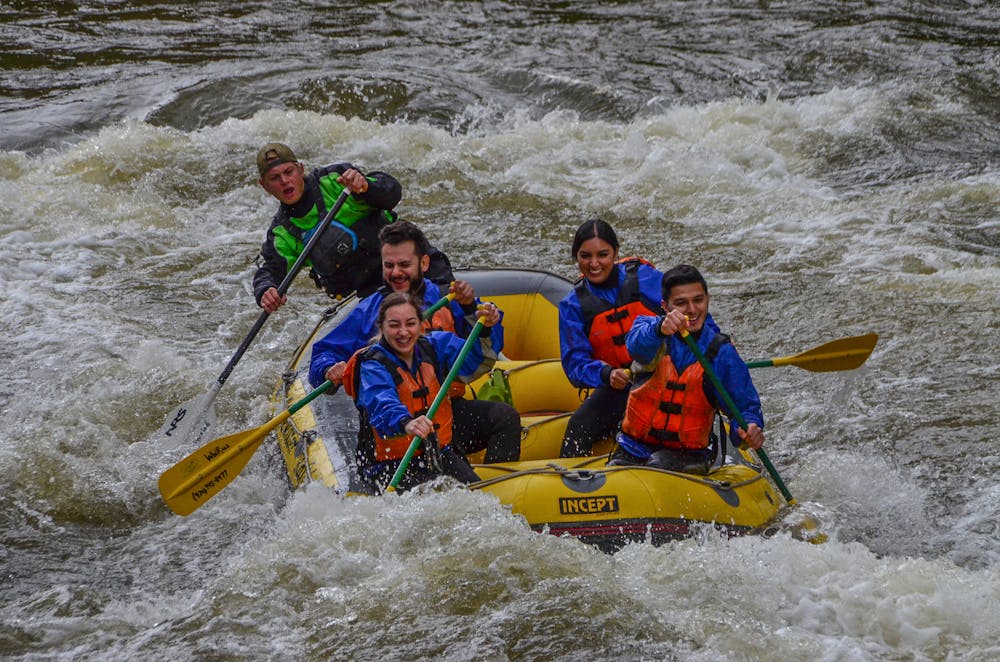Is Rafting Safe For Non-Swimmers?

If you can’t swim and want something outdoors to enjoy, whitewater rafting might be appropriate for you. While rafting can be an exhilarating experience, it’s also considered safe for swimmers who don’t feel confident. Many tour operators offer rafting tours and rafting accessories for beginners. Before signing up for a rafting trip, it’s essential to research and find a company that provides a trip that suits your skill level. Read on for our article on rafting safety, whether you should go whitewater rafting if you can’t swim, and how to make sure you stay on the raft while rafting. Whether you are a beginner or an experienced whitewater rafter, it is crucial to understand these risks and take the necessary precautions to minimize them.
 River Classifications and Non-Swimmers
River Classifications and Non-Swimmers
Many river guides will allow non-swimmers to participate in Class I and Class II rapids. These are more straightforward rapids that don’t pose much danger. Class I and II rapids are perfect for families with children as young as 5 or 6 years old and older adults. Class III rapids are a little hairier, but some outfitters will allow non-swimmers to ride. If you don’t have strong swimming skills, stay away from treacherous Class IV and V rapids. Many outfitters do not enable non-swimmers to participate in Class IV or V runs.
Do I Need to Know How to Swim?
No, you don’t have to know how to swim to go rafting. Whitewater rafting is possible without solid swimming skills. Rafting is a great way to experience the natural beauty of a river and doesn’t require special skills or knowledge. However, you must be able to paddle and maneuver the raft. Whitewater rafting is generally considered safe for non-swimmers, but the sport has inherent risks.
One of the biggest dangers of whitewater rafting is being thrown off the raft during a whitewater rafting trip. This can cause serious injury, so always wearing a life jacket and staying on board is essential. Rapids can also be unpredictable and dangerous, so listening to guides and following their instructions is important. Finally, underwater obstacles like rocks and logs can be dangerous, so it’s crucial to stay on board the raft when whitewater rafting.
Is Rafting Safe?
Rafting is a great way to explore nature and get wet. However, some people are not very good at rafting because they are not good swimmers. Are rafting trips safe for non-swimmers? The short answer is yes; rafting trips are safe for non-swimmers. While there is always a risk of injury in any outdoor activity, rafting is considered a safe sport for people of all ages and abilities. Additionally, most rafting tours include a safety briefing and a guide trained in first aid and CPR.
If you’re thinking about rafting but aren’t sure if you can swim, don’t worry. Most whitewater rafting companies provide life jackets for all passengers. Also, the rapids are usually moderate for beginners. Therefore, it is essential to exercise caution when participating in water-related activities.
Don’t hesitate to contact the company for more information before booking. If you’re rafting a gentle river, you can ride it even if you can’t swim. However, if you’re rafting more challenging rivers, you’ll need to be able to swim to navigate the rapids safely. Therefore, if you are not comfortable in the water, it is best to learn to swim first before rafting.
Am I Putting Myself in Danger?
Many people believe that rafting is only for experienced swimmers. However, the truth is that rafting is an excellent activity for all types of people, regardless of their swimming ability. Even non-swimmers can enjoy whitewater rafting without putting themselves in danger. Most of the risk in rafting comes from the rapids themselves, not the water. You can raft safely even if you don’t know how to swim if you work with a reputable, experienced rafting company.
Keys to Staying Safe in the Water
Staying on a raft while whitewater rafting can be challenging, but it’s essential to keep safe. You can do a few things to make staying on the raft easier for you. First, make sure you’re sitting in the middle of the raft. This will help you stay steady. Next, grab the rope on the raft’s side to help you stay put. Finally, keep your legs and feet together. This will help keep you from slipping off the raft.
You will also receive a life jacket and helmet when white water rafting. You also get a paddle to keep the raft on course. The key to staying on the raft is maintaining balance and remaining seated. If you can’t stay on the raft, you can grab the ropes on the raft’s sides.
Is It Hard to Swim in Rapids?
Whitewater river rafting and kayaking are popular outdoor activities, but can you swim in whitewater? There are no easy answers. Whitewater is a general term used to describe fast-moving water, which can be anything from gentle Class I currents to rough Class VI rapids. So can you swim in whitewater? It depends.
Know the hazards and navigate the river safely before attempting whitewater swimming. Always wear a life jacket and ensure your gear is in good condition. Unless you’re an experienced swimmer, consider hiring a guide to help you navigate the river safely.
Can I Fall Off the Raft?
If you are drifting down the current and accidentally fall off the raft, don’t panic. First, try to get back on your raft. If that’s not possible, try to find something to hold on to so you don’t get swept away. If you can’t do both, swim to shore. If you’re in a remote area, stay afloat until help arrives. If you see other people fall off the raft, try to help them stay afloat and guide the rescue team to their location.
Additional Safety Tips for Non-Swimmers
If you decide to sign up for whitewater rafting, here are a few things to keep in mind for safety reasons:
Choose a reputable company:
Make sure the company is licensed. Before obtaining a license, an outfitter must demonstrate that its employees are well-trained and that its gear and equipment meet standards. They must also demonstrate their knowledge of the route to minimize customer risk.
Never take off your lifejacket:
You must wear a flotation device and a helmet. If you are already on board, do not loosen or take off your life jacket, even if you feel uncomfortable.
Wear appropriate clothing: Wear appropriate clothing:
Wear a warm swimsuit when rafting in cold water. Even if you wear a flotation device, your body temperature drops rapidly when exposed to cold water, which can be dangerous.
Listen to the guide:
You will learn basic safety techniques before the ride. If you fall, immediately lie on your back and raise your head. Your feet should be pointing downstream. At the same time, lift your hips because there are rocks below you that you cannot see.
